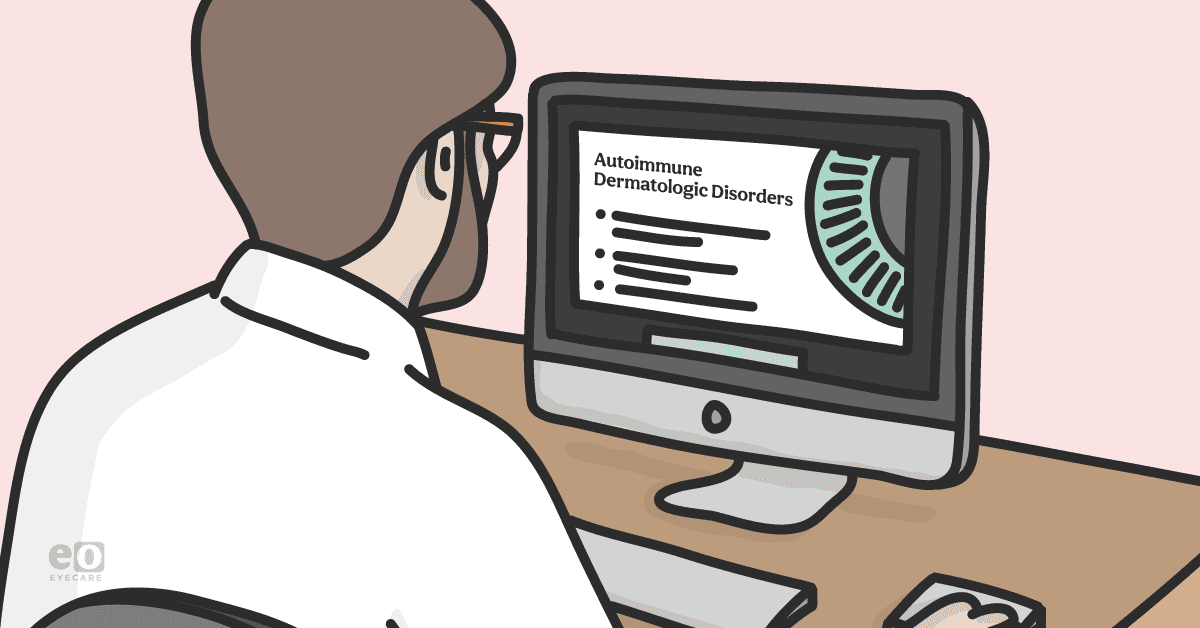Introduction
- Rheumatologic
- Dermatologic
- Endocrine
- Vascular
- Psoriasis
- Systemic lupus erythematosus
- Scleroderma
Psoriasis1-4
Psoriasis - Epidemiology
- Disease
- Prevalence
- 0.5-11.4%
- Incidence
- 100 per 100,000
- Men: Women (1:1)
- Ages
- 30-39
- 50-69
- Prevalence
- Eye manifestations
- 10% of the disease group
- Preceded by skin symptoms
- Men>women
Psoriasis - Mechanism
- Immune-mediated disease
- T-lymphocytes
- Dendritic cells
- IL-17, IL-23, TNF
- Hyperproliferation and abnormal differentiation of
- Epidermis
- Inflammatory cells
- Vasculature
Psoriasis - Screening guidelines
- None to date (to screen for ophthalmic complications)
- Good eye questions
- Eye discomfort (pain/irritation//foreign body sensation/dry eye/photophobia)
- Swollen/painful eyelids
- History of red eye
- Periocular lesions
- Changes in vision
Psoriasis - Presentation
General
- Well-demarcated plaques predominately on extensor surfaces
- Pink/salmon colored
- Silvery-white scale
- Nail pitting
- Psoriatic arthritis
- Koebner phenomenon
- Auspitz sign
Ocular
- Occur during psoriasis exacerbation
- Involve conjunctiva or eyelid
- Psoriatic arthritis may be linked to iritis
Breakdown by location in eye
Eyelid
- Most prevalent ocular finding
- Mechanism (proposed)
- ↑ epithelial turnover
- ↑ volume of cell production
- ↑ shedding
- ↑ Block meibomian duct
- Presents as
- Meibomian duct blockage
- Burning
- Itching
- Red/swollen lid
- Crusty/flaky lid
- Ectropion 🡪 trichiasis 🡪 madarosis 🡪 loss of lid tissue 🡪 vision impairment
- Psoriatic plaque on lid
- 2.3-7% patients with psoriasis
- Complication
- Meibomian gland dysfunction
- ↓ Tear breakup time
- Abnormal gland secretions
- ↑ plugging and thickness indices
- Meibomian duct blockage
Treatment for blepharitis, psoriatic plaque, and ectropion, trichiasis
- Blepharitis
- Lid hygiene
- Warm compress
- Eyelid massage
- Lid scrubs (baby shampoo)
- Erythromycin ophthalmic ointment at night
- Psoriatic plaque
- Topical corticosteroid
- Topical tacrolimus
- May need co-management with dermatologist
- Ectropion, Trichiasis
- Lubricating drops/ointment
Conjunctiva
- Presentation
- Chronic nonspecific conjunctivitis with or without eyelid margin lesions
- Redness
- Tearing
- Thick yellow discharge
- Plaque formation on conjunctiva
- Chronic nonspecific conjunctivitis with or without eyelid margin lesions
- Complications
- Xerosis, symblepharon, trichiasis
- Dry eye
- Management
- Artificial tears
- Erythromycin ophthalmic ointment
Cornea
- Presentation
- Punctuate epithelial keratitis
- Superficial or deep opacities
- Stromal infiltrates
- Neovascularization
- Erosions
- Scarring
- Stromal melts
- 3 components
- Thickening of epithelium with erosions
- Infiltrated zone under bowman later with superficial vascularization
- Homogenous deep stromal opacity
- Punctuate epithelial keratitis
- Other
- Eye pain
- Discomfort
- ↓ visual acuity
- Potential management
- IV methotrexate (psoriasis treatment)
- Keratitis
- Conjunctival injection
- Dry eye
- UV therapy (psoriasis treatment)
- Eye pain
- IV methotrexate (psoriasis treatment)
Uvea
- Anterior uveitis
- 7-20% of patients with psoriasis
- Bilateral: 62% of cases
- Duration: 11.2 weeks
- Symptoms
- Acute
- Pain
- Red eye
- Photophobia
- ↓ vision
- Minimally reactive pupil
- Posterior synechiae may create irregular pupil
- Acute
- Associated with
- Psoriatic arthritis
- HLA-B27
- Treatment options
- Corticosteroids
- Cycloplegic agents
- Immunomodulatory therapy
- Anti-TNF
- Lens
- 63/100 had bilateral cataract (Incidental finding)
- Diagnosis
- Clinical
- Biopsy
- Acanthosis
- Parakeratotic scaling
- Increase size of stratum spinosum
- Decrease size of stratum granulosum
- Munro micro-abscesses
- Labs
- Genetic testing
- Management
- Dependent on region of eye affected

Sign Up to Keep Reading

